![]()
Menu:
Orkney Sea Trout Fishing in Saltwater
I think it would be fair to say that Orkney’s salt water sea trout fishery is a far cry from the halcyon days of 50 years ago. This doesn't’t mean that sport nowadays is poor. Far from it, but it’s a lot harder.
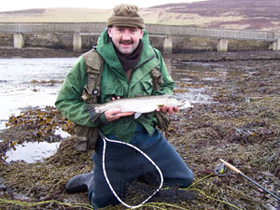 |
Brian Foreman with a superb Sea trout straight from the salt. Brian is a local Guide and can be contacted at: |
Whereas in the distant past when large catches of quality fish were commonplace and relatively easy to find, today’s salt water angler has to put in a lot of effort and time, often for meager reward. On the plus side, fewer local anglers are plying their trade in salt water and it is quite possible to find yourself alone in one of the hot spots. If you are fortunate enough to be in the right place, at the right time, and you know what you are doing, then you can still expect a few fish. If you can manage to string together a few “right places” etc on the same day then you will enjoy one of the best day’s trout fishing possible in the United Kingdom. And it’s not just the fishing. The ever changing sky, light, tide and weather, the solitude and abundance of wildlife all add value to an unique sporting experience.
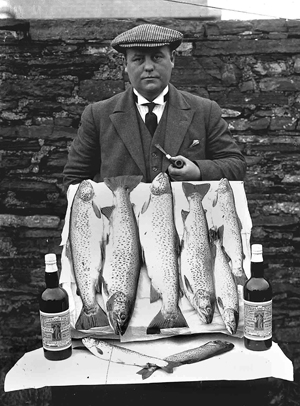 |
Fifty years ago catches of Orkney Sea trout like this were not uncommon its good to know today's anglers are more inclined to return fish |
Before we get into the technicalities of the sport, a few words on the ecology of Orkney’s anadromous salmonid. There are no rivers as such in the Orkney Islands. Even our burns are pretty small. We don’t have much in the way of estuaries either so the transition from fresh water to salt is pretty immediate. Our freshwater lochs support large populations of brown trout and lochs with unobstructed sea access are a source of some of our sea trout population. However, our “sea burns” are also a major sea trout source. Sea burns are basically burns that run directly from their watershed to the sea, and are not connected with established brown trout loch fisheries. Where sea burns enter the sea, there is often found an “ouse” or tidal lagoon. Sea trout run the burns in the back end, spawn, and return to the sea fairly quickly. Some of our sea burns are very small and clearly will not recruit much in the way of fish numbers. Indeed, some of the burns may dry out completely in the summer time. Sea trout fry smolt fairly quickly and migrate to the sea in the spring of their second year. Needless to say, some very small fish can be caught in pure salt water.
It is thought that our smolts, once they go to sea, do not really travel that far from their native burns. They are particularly fond of the ouses and probably nip in and out of these with the tides. Finnock and mature fish probably do not move around that much either and all are attracted to their natal stream areas in the winter months – regardless of whether or not they spawn. Non spawners are known locally as “maidens” and run in the 12 oz to 3 lb range. These fish are your proverbial “bars of silver” and the bigger specimens, if in peak condition, can be a real challenge on light tackle. Fish in varying degrees of spawning condition, normally in the 1 lb to 4 lb range but can run into double figures, can become quite dark in the autumn and are not quite as silver as maidens in the springtime. Kelts, I hear you say. But you must remember that these fish return to sea within days of spawning in November and start feeding voraciously over the winter months. As with all trout, some recover from their spawning exertions better than others and, as a rule of thumb, all out of condition fish should be returned. Orkney sea trout are predominately shoaling fish and where you find one, there will inevitably be others in the area.
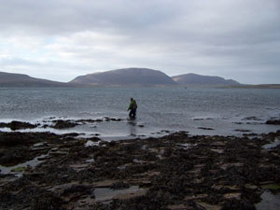 |
Sea Trout fishing in Scapa Flow |
Ok, let’s cut to the chase. Where exactly do we find these fish in Orkney and how do we catch them? Starting with the latter, I will give you my completely biased views on the subject.
As far as I’m concerned, there is only one way to fish for sea trout in the sea and that is by means of a loch fly rod, fly reel and line an something at the end of a 9 foot leader. Leave your spinning rods, beach casters, bubble floats, tobys and rapalas at home. The terminal tackle can either be artificial fly, live worm, fish strip or a combination of them all. To many anglers, the idea of fishing with bait for game fish is a bit of a sacrilege. Each to there own. I don’t fish with bait for brown trout. I grew out of the practice more years ago than I’d like to remember. Bait in the sea is a different proposition altogether and, when fished “Orkney style”, an accomplished art, can provide exhilarating sport. “Orkney style” involves roll casting a good length on line into fish holding water and pulling back with a steady retrieve. The fly or bait is seldom more than a few inches below the surface and, joy of joys, sea trout like to chase. This is very visual fishing with bow wave follows the order of the day. Often, the bigger the wave the better the fish. Why on earth would a sea trout chase after an earthworm being horsed back through the waves on a shingle beach and devour it as if there was no tomorrow?. Probably because it looks like a sand eel but tastes like a garden fly. Mackerel strip has its aficionados, and I am one. Sea trout really hammer into a small sliver of belly and more often than not the fish are scissors hooked. I’ve even had success using strips of orange Arctic Char belly pulled back fast. Orange is a powerful colour for many species of salt water fish and sea trout are no exception. This takes us on nicely to fly patterns.
I’m convinced that hungry sea trout are not really all that fussy about text book tyings and will take virtually anything that looks remotely worth devouring. They enjoy a pretty catholic diet in salt water, with anything from humble lug worms to 15 spined sticklebacks appearing on the marrow spoon. Gammarus shrimps, sea slaters, sand eels and juvenile coalfish probably make up the bulk of stomach content. I’ve seen some very clever imitative patterns being used to good effect but the same can be said for a wide range of traditional “fancy” wets and mini lures.
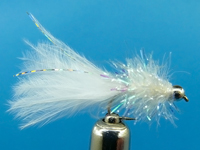 |
Malcolm's White IPN |
My personal favourites include Nic’s Lure, Brian's Firewater lurel, Platinum Blonde and White IPN. I like to paint eyes on my sea trout flies. It’s probably just a fad, but sea trout eat things with eyes so why not. Nic's Lure is basically a Whisky Fly variant which came off the vice of top “ex pat” Orkney angler Sandy Nicolson. This “hot” orange pattern seems to provoke aggression in sea trout – in particular the bigger mature fish. The Baltic Special is basically a modern version of the Teal Blue Silver with a bit of sparkle which sea trout seem to like. The IPN and Platinum Blonde are more in the sand eel imitation ilk. Both have accounted for some superb sport over bare sand. The Blonde in particular did really well for me at the start of last season on a day when I found a shoal of maiden fish in the 12 oz to 3 lb range, accounting for around a dozen and several more just undersized. I’ve found it often helps if the fly makes a bit of a plop when it hits the water, and the IPN certainly does. Rather than spooking the fish, it often attracts their attention and on seeing the opportunity of a tasty snack they will race to get there first. Same scenario obviously applies when fishing bait.
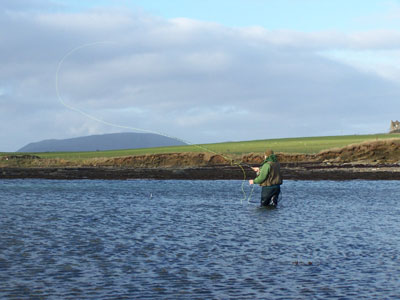 |
Wading out and fishing into the shore can prove very rewarding |
Orkney anglers generally fish with one fly on a 6lb to 8lb leader. Fishing with two or three flies is quite possible but there is a much increased chance of breakage due hooking weed during play or being smashed by multiple hook-ups. Our sea trout flies are usually tied on fairly heavy hooks, with size 8 Kamasan B175 a popular choice. This is mainly to give the flies some grip in the water and to stop them skating on the surface. Same applies with fly lines. With salt water being denser than fresh, an intermediate or old fashioned sink tip line helps to present the fly or bait just below the surface. I’m absolutely certain that most, if not all, of the modern salt water fly patterns, Deceivers, Crazy Charlies, Clousers etc, in smaller sizes, will do the business with Orkney sea trout.
Location is fairly straightforward. Or is it?. It’s one thing knowing where to go for a salt water sea trout, but getting there at the right time, at the correct state of tide and in the most suitable weather conditions is something else. Success very much depends on the aforementioned factors. If the fish are there then you will catch them. Generally, Orkney’s sea trout should be present in almost any shallow coastal water areas and bays on the east side of the Mainland, east coast of Hoy and all Scapa Flow beaches. They prefer beaches with mixed sand and shingle, often with a burn, ditch or land drain fairly close by. They are also quite partial to tidal runs. Fish are undoubtedly drawn to any fresh water running into the sea. As a rule of thumb, sea trout are seldom found in water deeper than a few feet and often the best fish are lying in water just deep enough to cover their backs. Chest waders are essential but I’ve often seen anglers wading out as far as they can and then casting out ever further. More often than not they have made the mistake of wading through the shoal of fish, and spooking them in the process. A better tactic is to wade out in an area near where fish hold, and, staying out as far as possible, traverse till you are within casting distance of the holding area and fish “back in”.
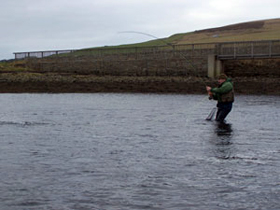 |
Playing a maiden fish under the Finstown Brig |
Local anglers chose their locations very carefully. It often depends on the state of the tide and very much depends on wind direction. A strong onshore wind will colour up the salt water very quickly and render the area unfishable. Tides are very complicated. Some places will hold fish in almost any state of tide but a lot of the best locations are extremely quirky. There are high water spots, low water neap marks, low water spring marks and so on. Far too much to go in to in one brief article and I probably would not tell you anyway. Orkney anglers guard closely their sea trout knowledge. It comes hard earned and is not given away easily. The best way to learn is to get out there and have a go. Trial and error, with blanks galore, will eventually start paying dividends and you will be hooked. How much does it cost for a day on an Orkney sea trout beach? Well absolutely nothing. For visiting anglers, you’ve got to get here first off course but after that it’s a case of the rod clamped securely to the car and away you go. In the springtime, access over most farmland is not much of a problem because the cattle are still inside but if you are at all in doubt, seek permission from the landowner before crossing their land. There are lots of roadside sea trout locations but these are inclined to get hammered by locals. As with all sport, there’s no gain without pain and a good hike to a remote beach can pay dividends. Ok, this goes against my better judgement but here are a few locations you can try: Bay of Firth, Finstown Brig, Inganess Bay, Deer Sound, Sebay, Scapa, Waulkmill, The Bush, and on Hoy, Mill Bay, Pegal Bay, Creekland, Moness and Lyrawa.
Orkney salt water sea trouting is one of the extreme sports of British game fishing. It is mainly done when the weather is absolutely dire in early spring and late autumn. This is the sport for anglers with masochistic tendencies. If standing up to your neck in freezing cold salt water; getting lifted off your feet by the breaking swell and digging your way through the snow drifts back to your car – if you can find it, is what turns you on, then welcome to paradise.
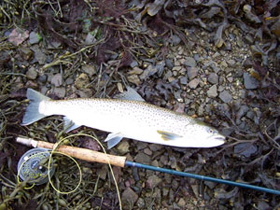 |
A superb 3lb. Maiden Orkney Sea trout |
A word of caution however. Orkney’s sea trout are undoubtedly in decline. Contributing factors include agricultural pollution, canalisation of spawning burns, too many seals and probably the effects of global warming. But the greatest damage to the species in Orkney waters has without doubt been caused by the commercial farming of salmon and sea trout in the sea in general and sea lice therefrom in particular. Were it not for the dedicated efforts of the Orkney Trout Fishing Association’s environment committee to minimise the intrusion of fish farms into prime sea trout locations, I’m convinced the situation here would be a lot worse. I would urge all visiting sea trout anglers to join the OTFA and support the cause. Finally, I would urge all sea trout anglers to exercise restraint. By all means keep a few fish for the smoker but the killing of everything over 12 inches in length should now be a thing of the past. If you’re not intending to scoff it for tea, admire it’s beauty, thank the gods for allowing you to catch it and slip it back into the briny.
Malcolm Russell
Click on flies to view larger image
Brian's Firewater Lure |
Nic's Lure |
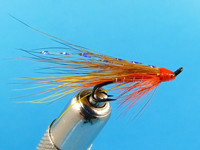 |
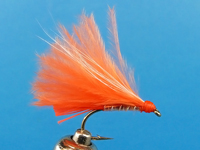 |
Hook:
Salmon low water 12 Notes:Build up a even head of thread and varnish |
Hook:
Heavy gauge 6,8 & 10
|
Stinger |
Platinum Blonde |
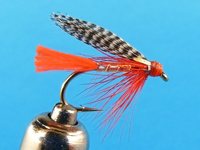 |
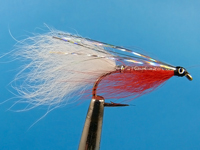 |
Hook:
B175 8 &10
|
Hook:
B175 4 |
Orkney Sea Trout facts:
Season: 25th February - 31st October (Sundays excluded) Best time March, April, late August, September and October
Size Limit: The OTFA insist all fish under 12 inches should be returned